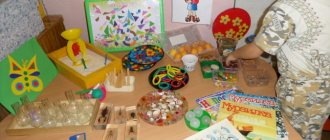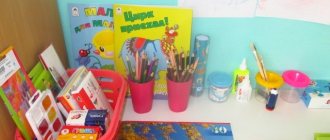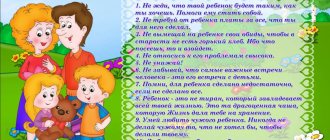The meaning and purposes of theatricalization
Theatricalization is a type of play activity that is used to reveal the creative potential of children using dramatization techniques, that is, role-playing according to a pre-agreed scenario, as well as various exercises aimed at mastering acting skills.
Theatrical performance is an indispensable element of matinees
Theatricalization is valuable because it includes work on the development of monologue and dialogic speech, and this increases the communication skills of children. Theatricalization involves:
- working on the expressiveness of characters’ lines;
- expansion of the child’s active and passive vocabulary;
- improving the pronunciation of speech sounds, as well as intonation structure.
In addition, the goals of theatricalization are:
- comprehensive acquaintance with various manifestations of reality (professions, animals, natural phenomena);
- stimulation of the child’s creative potential (through songs and music, dancing, games);
- development of the child’s emotional sphere due to deep experiences during the game;
- formation of social behavior skills;
- introducing preschoolers to reading;
- development of directing skills;
- embodiment in a creative impulse of the mood, character and process of character development of the character.
Theater is a magical world. He gives lessons in beauty, morality and ethics. And the richer they are, the more successful the development of the spiritual world of children is...
B. M. Teplov, Soviet psychologist
Video: presentation of types of theater for kindergarten (tabletop from knitted toys, on jars, on spoons, shadow theater)
Non-traditional types of theater
In addition to the usual materials for puppet theaters, alternative types can be used.
These can include plastic and wooden spoons. Images of characters are drawn or attached to them. When painting on plastic, you should use acrylic paint. If you have to paint with gouache, it is mixed with a small amount of PVA glue.
Interesting options are made from yogurt jars and plastic bottles. They are covered with colored paper, images of characters are attached and fragments of scenery are added. The results are voluminous mini-stories. Such figures do not require additional decorations and develop children's imagination.
Playing theater is a useful and interesting activity. It improves memory and develops oratory skills. The child learns to retell the text, highlight the main points, not be afraid of public speaking, and parents have the opportunity to discern the child’s talents.
Work in the theater corner
Activities related to theatrical performances in kindergarten are implemented by several types of play activities:
- Director's games. In them, the child only leads the doll, conveying the image of the character with intonation and some other techniques. The possibilities of pantomime here are also very limited, because the toy is almost static (puppets on canes, puppets).
- Dramatizations. The baby plays the role himself, without resorting to the mediation of dolls. The young actor is able to actively use intonation, facial expressions, movements and gestures to enter into the character of the hero.
- Dramatizations with bibabo, finger, floor or scarf puppets. The baby acts for the character, giving him his voice. The work is carried out from behind a screen or with a character in hand.
Working with floor dolls is very difficult, but exciting for children - you cannot use facial expressions
- Improvisation. Children act out themes, not plots. Such theatrical activity requires almost no preparatory work, but is the most complex type of game. Various theatrical props can be used for improvisation.
The theater corner, which has everything necessary for the relevant activity, allows you to create a comfortable environment in the group for the development of the creative abilities of students. Theatricalization is a special area of the educational program for preschool institutions, because it gives children the opportunity not only to explore the world around them, but also to learn to live in harmony with it. In addition, theatrical performances help children become more self-confident, which is also important for their personal growth - which means that a kindergarten cannot be without a theater corner.
Hand puppets for home theater
Felt doll
Will need
- Sketch of a puppet toy.
- Two sheets of felt, A4 size.
- Small pieces of colored felt.
- Thread and needle.
- Glue gun.
- A sheet of thin cardboard.
We start work by creating a pattern. To do this, draw the sketch onto a sheet of cardboard and cut it out. You will get the main pattern of the figure and individual small details: eyes, muzzle, palms, tummy, ears. The number of details depends on the choice of sketch of the puppet hero.
Then we transfer all the details onto felt. We select the color scheme according to our taste or the content of the fairy tale. The hare can be white, gray or pink, and the fox yellow or orange. If you are doing a craft with your child, let him choose what color the characters in your play will be.
We cut out the parts and pre-assemble the toy, placing all the parts in the places where they should be. If the result is satisfactory, we begin the final assembly. First, we make one main piece out of felt. We sew on all the parts that can be sewn. We sew with a buttonhole stitch. We glue small parts with a glue gun. We put all the parts together in accordance with the sketch.
If the toy has ears, we attach them last. To do this, we fold the two main parts with the right sides facing inward. We apply the ears in such a way that the edges of the part coincide with the edges of other parts, and the tips of the ears look inward. We sew all the details along the edge with a buttonhole stitch and turn the toy inside out. The glove puppet is ready, and the ears will stick out funny on the top of the head.
Sock puppet
Original dolls are made from ordinary children's socks.
To make it you will need a sock, cardboard, a small skein of thick thread or yarn, pieces of fabric for the mouth, sewing thread and buttons, and a glue gun. You can take a sock in a plain color or with a pattern, polka dots or stripes - all this will create the image of a future toy.
We make a blank for the mouth from cardboard. To do this, fold a cardboard rectangle 7 cm wide and 20 cm long in half. We round the corners along the width. From the fabric for the inside of the mouth we cut out a blank according to this template.
Trim the toe of the sock. We cut off the edges along the edge of the workpiece. Glue the cardboard blank inside the sock using a glue gun. At the same time, we fold the edges of the fabric onto the cardboard. Glue the fabric interior on top.
Making a hairstyle for the puppet. Take thread or yarn and wrap it around your hand several times. Tie in the middle and cut the ends. If you spread your fingers wide, you will get a long hairstyle. Sew the hairstyle to the sock.
Let's make eyes. We take two buttons and sew them to the sock, overlapping one on top of the other. You can use ready-made eyes or ones drawn and cut out of cardboard. You can complement the image with any details, make eyes from balls of cotton wool or add decorative elements.
Center for theatrical activities in the group of preschool educational institutions
Marina Yanchuk
Center for theatrical activities in the group of preschool educational institutions
I invite you to the wonderful world of children's theater .
In modern kindergartens, where space is quite limited, it can be quite difficult to allocate separate places for corners. Therefore, we have combined educational centers into a complex . Center for books , visual arts and theater . At the same time, the subject content corresponds to a number of principles:
• mobility
• rotation (the contents of the corner vary depending on the goals of educational work in a given month, the time of year, and the interests of the children)
• accessibility (all children have the same rights and responsibilities related to the use of theater ).
In the center there is a doll beloved by children - Harlequin. He is an instigator and assistant for children in any kind of theatrical activity . It not only invites you into a fairy tale, but also helps in introducing children to the basics of theater . This is the keeper of the corner.
Theatrical activity organizationally permeates all routine moments: it is included in direct educational activities (getting acquainted with a literary work, in the joint activities of children and adults in their free time (making attributes or heroes, drawing up a script, and is carried out in the independent activities of children . It helps to make life children in a group are more exciting and varied.
This is how we carried out project activities during the book week “In the World of Suteev’s Fairy Tales”
, the results were an exhibition of joint creative works based on the author’s fairy tales, a dramatization of the fairy tale
“Under the Mushroom”
and the production of a soft lapbook.
The laptop consists of three pages. Each of them presents one fairy tale. It can serve as a tabletop theater , as well as solve educational problems in individual work.
Theatrical activities develop the emotional sphere of the child, forcing him to sympathize with the characters and empathize with the events being played out. Which is very important for the children of our group . The shortest path to emotional liberation of a child, removal of tightness, learning to feel and artistic imagination is the path through play. The theater of moods or emotions helps to successfully solve these problems
to theatrical activities , since in the process of working on the expressiveness of characters’ remarks and their own statements, the child’s vocabulary is imperceptibly activated, the sound culture of his speech and its intonation structure are improved. These are director's games. In our center they are represented by table theaters , shadow theaters , theaters on flannelgraph or magnets. In the tabletop - we use a toy theater , a picture theater , a cube theater , theater and 3D models.
In dramatization games, the child plays a role as an “artist”
, independently creates an image using a set of means of verbal and non-verbal expressiveness.
Types of dramatization are games that imitate images of animals, people, and literary characters; role-playing dialogues based on text; staging of works; staging performances based on one or more works; improvisation games with the acting out of a plot (or several plots)
without prior preparation.
In our corner they are represented by finger theater , bibabo dolls, glove dolls, handkerchief dolls, masks and costumes.
The required components of our theater corner are the following attributes:
a) screen (We have two of them: large and small, and both are multifunctional. A small screen can be used in a shadow theater , in a finger theater , and with small puppets. It can also serve as a cash register in different types of role-playing games. A large screen can serve a corner of privacy for children, a “house”
, the color of the canvas changes depending on the time of year.
b) a mummers corner (hats, beads, fans, costume details, glasses, cap masks, theatrical props , scenery, etc.).
theatrical activities interesting and attractive is the presence of a chest with “Magic Things”
:
— Magic box, bag (to play up the appearance of heroes, some thing, a surprise moment;
—Magic wand (used for transformation, removing shyness when playing a role, to change the plot);
- Magic mirror (the child turns and sees himself in the mirror as whoever he wants,
— A pipe and a jug;
— The tablecloth is self-assembled and the carpet is airplane;
— Boots - walkers
- Seven-flowered flower
In the same corner you can organize a “workshop”
for the participation of children in the production
of theatrical attributes , masks, posters, tickets.
The chest of drawers contains the necessary material for this. Our special value is the opportunity to introduce children to works of art with the help of a filmoscope and filmstrips. Looking through frames of fairy tales, we can immediately discuss the actions of the heroes and their emotional experiences.
Also in the corner there is a collection of audio fairy tales, cartoons and musical accompaniment for dramatizations and performances.
The created theater corner contributed to awakening in children a sustainable interest in theater , revealing their individual abilities and uniting into a friendly team.








